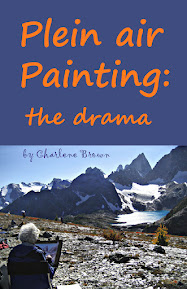The dresses now on display at this church are part of an on-going project to increase awareness of the horrendous findings of the MMIWG.
My interest in painting this church relates to a much less dire controversy involving it and St. Paul’s Presbyterian Church in Banff.
The Canmore church, built in 1890 and 1891 in the ‘Carpenter Gothic’ style, was one of the first Presbyterian churches in Alberta. Ralph Connor, an ordained Presbyterian minister, was sent on a mission to the Canadian Rockies, serving Banff, Anthracite and Canmore about a hundred years ago. He was an ardent advocate of temperance, labour rights, and the progressive ideals of the Social Gospel movement.
In 1925, he was strongly in favour of joining other Presbyterian churches, as well as Methodists and Congregationalists to form the United Church of Canada. The idea was popular with his congregation in Canmore, but the Clerk of the Session in Banff (my grandfather, Jock Thomson) led a successful revolt to “ensure that St. Paul’s remained Presbyterian.”
This resulted in Ralph Connor serving the remainder of his mission in Canmore only. In spite of this, he played a leading role in bringing the various denominations together, and was soon called to serve in St. Stephen’s Church in Winnipeg.
By the time of his death in 1937, Ralph Connor had become a prominent figure in the United Church and a best-selling author of several books, some relating to "difficulties in the mission fields of the Canadian West." The church in this painting was named the Ralph Connor Memorial United Church in 1942.










